Account-Based Marketing: Merging the Power of Sales & Promotion For Ultimate Results
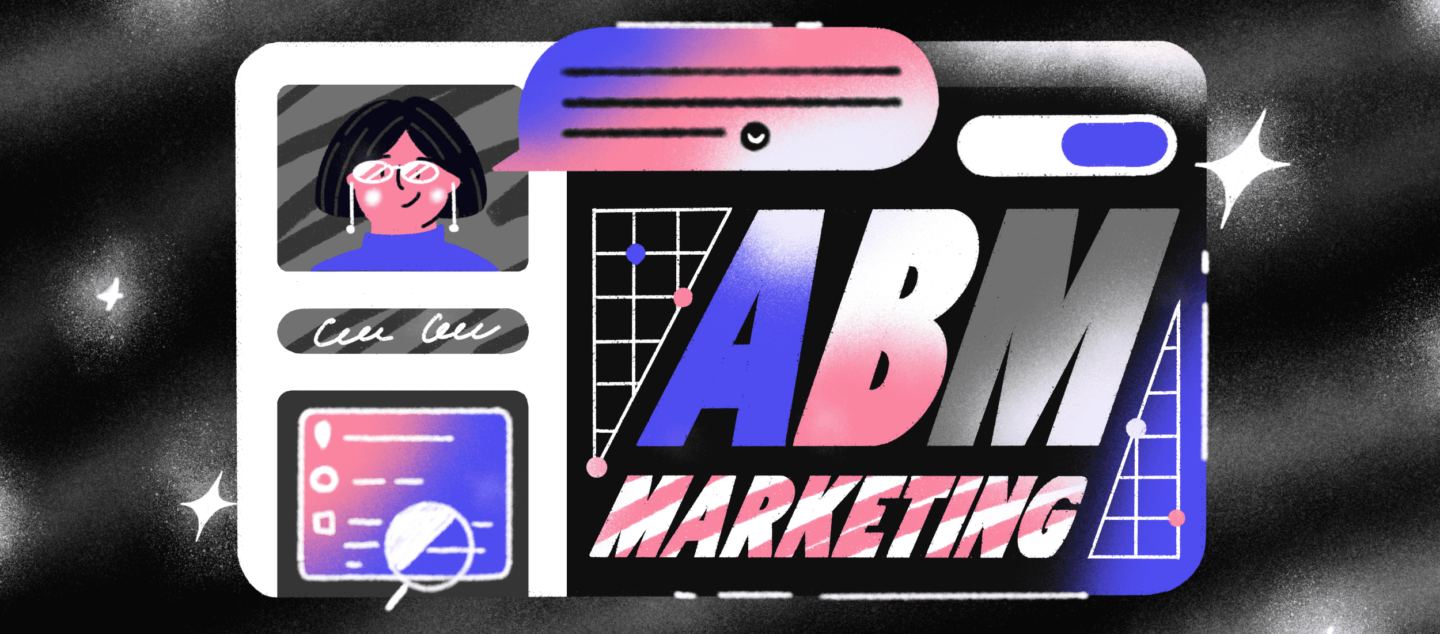
Imagine a perfect company promoting subscription-based software services. It saves a ton of human resources and budget by focusing on the clients with a high potential to buy. The sales team and marketers no longer spend their hours trying to appeal to thousands of potential customers. Both of them know which of your target audience accounts buy more. Thus, they cooperate to focus on them and:
1) catch their attention;
2) showcase the product;
3) encourage purchases based.
The two departments work like clock to reach and convert more clients with high potential to buy, not everyone.
It becomes more than real in your case as well, thanks to the ABM approach.
In this article, you’ll find out what is ABM marketing and learn how to leverage it in your enterprise from experts.
What is account based marketing?
This is a business marketing strategy that aligns marketing and sales departments by concentrating resources on particular target accounts on a market.
It has a more personalized and holistic approach at its core. The marketing message is based on specific needs and pain points of an account.
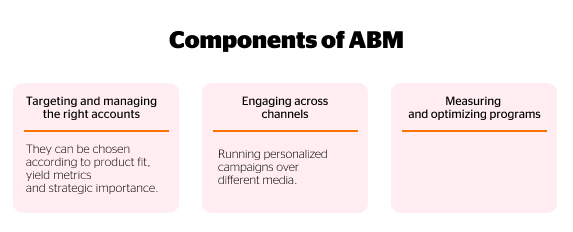
Being widely used in the B2B sector, this approach unites the marketing and sales teams to cooperate and target the best-fit prospects and convert them into clients. ABM marketing allows two departments to merge their expertise for efficient search, engagement, and conversion of prospects while focusing efforts on accounts that matter the most.
For example, when selling a SaaS product, both departments can figure out an optimal strategy to reveal companies that
1) really need their service;
2) are ready to pay for subscriptions on a regular basis.
Next, the marketing department generates content and messages (for example, chatbots or pop-ups): potential customers interact with these tools, thus providing some data.
The data gets recorded and analyzed by the sales and marketing departments to further personalize communication and find the most relevant prospects. Upon the end of communication, the campaign results are assessed.
Issues account-based marketing can solve withing your company
ABM strategy has become highly popular for B2B targeting any size companies. It is useful for long sale cycles with huge deal sums as well as for shorter ones.
How?
Here are key advantages ABM implementation can bring your team.
No more conflicts between sales and marketing departments
Account-based marketing encourages both teams to work in alignment and craft customized campaigns that would unleash a higher potential. By elaborating a common strategy and sharing roles, they can move more accounts through the pipeline and turbo-charge lead conversion.
It streamlines sales cycles
Deals that involve several stakeholders typically slow down the sales process. It takes a lot of time for a message to be transmitted from the lower level in the company to major decision-makers.
In account-based marketing, a sales cycle shortens considerably because:
- all prospects are served content simultaneously;
- sales reps don’t waste time on reaching out to unimportant prospects;
- reps can start interaction with targeted account directly through decision-makers, not other employees;
- ABM followers stress quality over quantity, so they earn more by applying fewer efforts.
It boosts ROI
87% of B2B marketers surveyed by ITSMA claimed that their ABM campaigns outperform other approaches from the ROI standpoint.
As a natural outcome, increased reward on investment is observed after a few months of practicing account-based marketing. The good news is that this approach allows measuring the income in clear numbers — its value can be estimated quickly and precisely.
More resources are left for what really matters
Instead of wasting their time on reaching out to a huge audience, sales & marketing specialists can narrow and focus their efforts on the most prospective accounts which are more likely to generate profit.
That frees up time and resources — they can be spent on some better initiatives.
Higher personalization
As it has been mentioned, the individual approach brings better results because sales and marketing teams merge their experience to deliver content that raises genuine interest and appeals to accounts’ pain points.
How is personalization achieved?
- Target audience is segmented, which allows the seller to come up with relevant offers.
- Targeted messages in pop-ups or chatbots can be shown/sent to users if they perform a particular action, for example, visit some particular pages on the website (which serves as the proof of their genuine interest).
- Reps send messages addressing particular companies or their representatives and targeting their paritucal needs and pain points.
- During communication, sellers can offer discounts and bonuses for prospects’ companies.
Reps, in turn, can create lead cards that include such information as their contacts, position, company credentials, visited website pages, preferred channels, product tags, and some comments clarifying the needs and requirements.
How Does Account-Based Marketing Work?
It aligns the experience of marketing and sales specialists and allows saving tons of time because the best-fit accounts are targeted and processed.
Prospects can be reached out through messages and advertisements, as well as pop-ups.
Imagine a situation, where you’d like to test your new product feature.
You’ve made research and defined that product marketers are more likely to buy it. But there are support, sales, marketing managers in your users’ database also. They don’t need it.
How to make the first buy without wasting resources on the second one?
Segment the audience. Collect all the leads who have a product marketing tag on their user card.

Now time to craft a message you’ll use in marketing campaigns. For this, you should understand why do they buy.
Thus, you go to analyze the user journey of the product managers who already bought from you. It makes you go into their user cards to see:
- What pages did they visit before purchase.
- What questions did they asked communicating with your agents.
- What marketing channels do they interact more, etc.
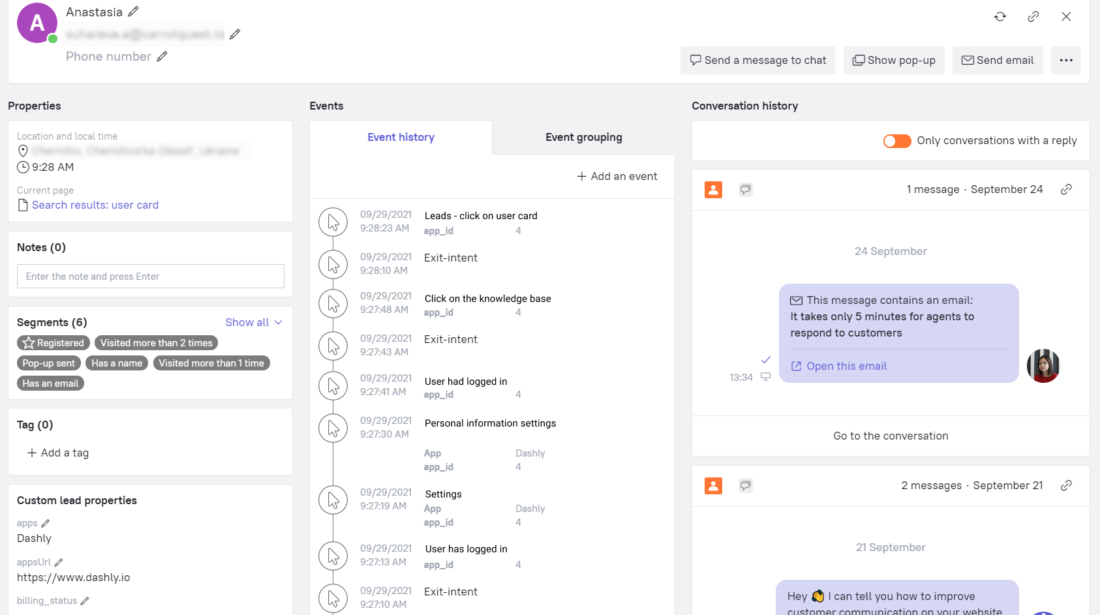
Now you know. The message is clear. You defined that they come to your website from Google and Facebook mostly.
For potential users: it means launching a look-alike Facebook campaign and PPC campaign that will lead similar prospects to the landing page presenting your new feature.
On this landing page, they’ll be visited by a pop-up offering a demo of your new feature. When they sign in, your sales should call them for an hour. It’s a priority.
For PMs who are your current users, you launch the same pop-up scenario. When visiting your website’s main page or this landing page, they’ll see this pop-up too.
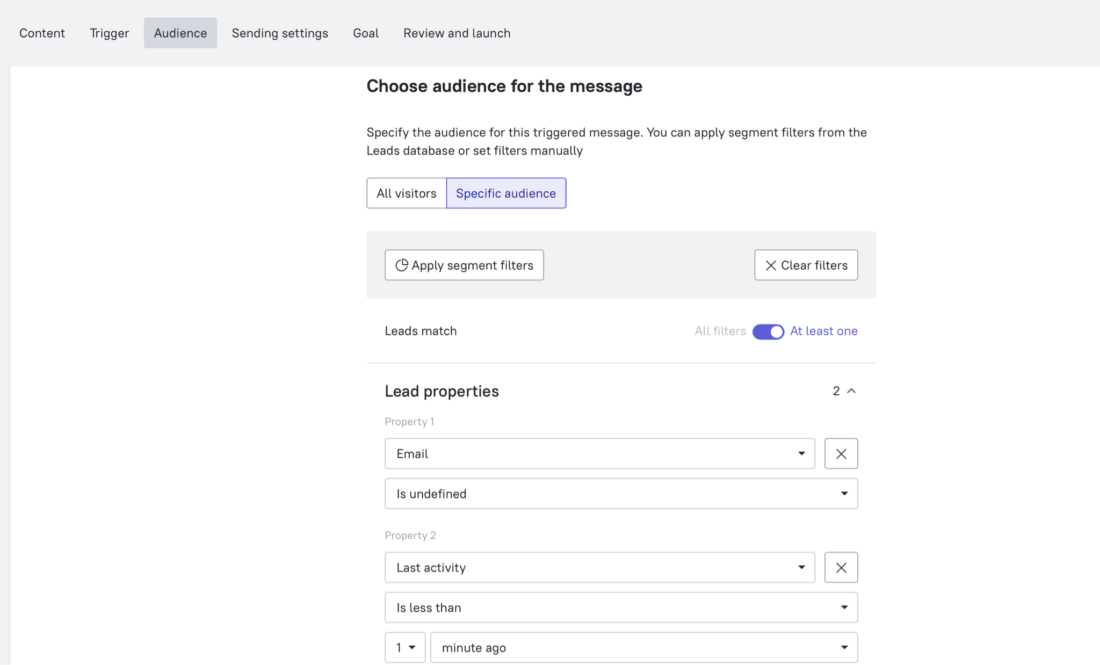
To set them up, you only need to specify the company source and product tags for current users. This way, targeted users will see the pop-up while others — won’t, or will see another tailored message.
In Dashly, you can identify triggers and events to qualify potential prospects and get some essential information.
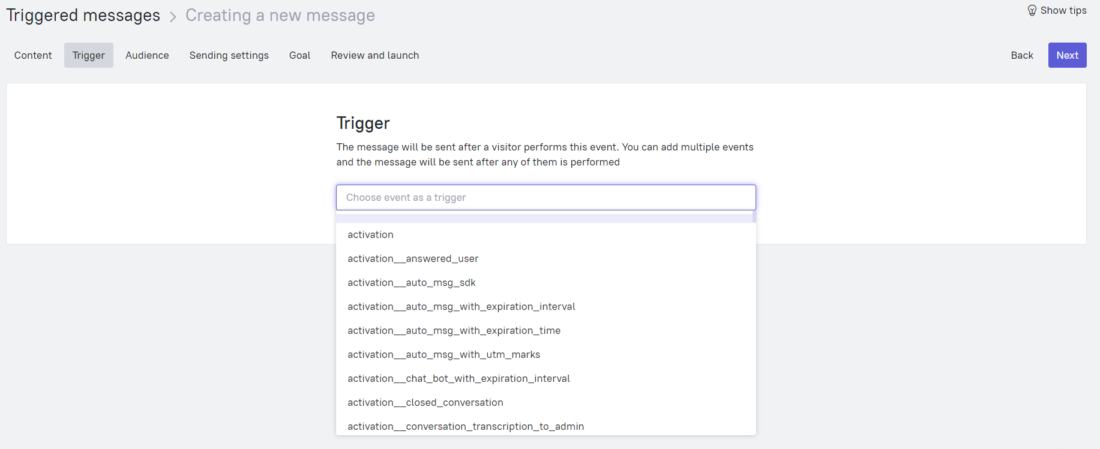
Once everything is ready, the account-based marketing campaign can be started.
It takes from 14 days to several months depending on the company’s preferences, requirements, and goals. During this time, accounts see or directly receive personalized messages aimed at solving their issues.
At this stage, communication with accounts is established through the communication channel they prefer.
But it is far from the end of how ABM can be implemented within your company.
Account-Based Marketing Examples
The amount of ways to implement account-based marketing is unlimited. Companies manage to figure out personalization tactics that reach the target more efficiently than ever.
Here are some examples to inspire you.
Solution-oriented blogging
You can run blogs that resolve particular problems or provide solutions that would target your accounts. To boost your professionalism in the audience’s eyes, you can raise pain discussions and tackle sensitive topics while providing useful information.
Posts can be aimed at particular company representatives, or at an entire industry.
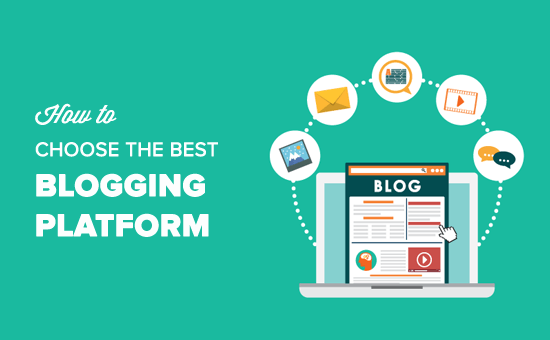
For example, WordPress published a blog post where it guided readers through the process of blogging platform selection. It
1) shows their professionalism;
2) encourages readers to choose their subscription-based CMS.
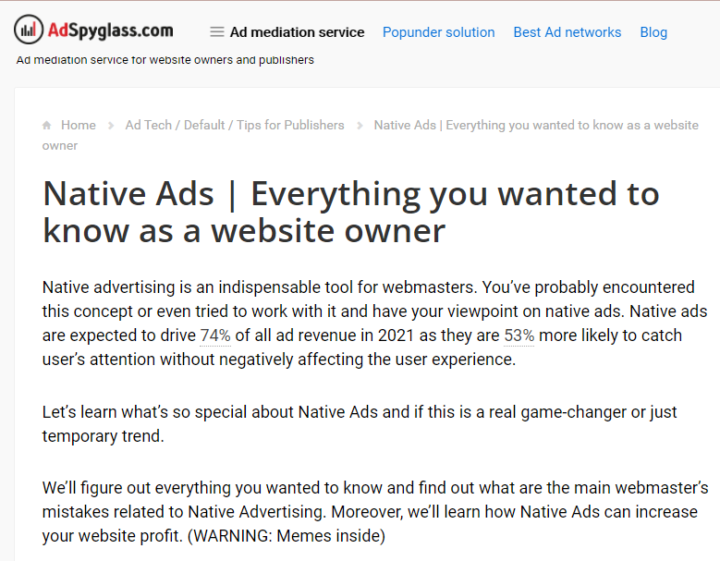
In this case, Adspyglass ad network targets website owners, explaining to them how native ads can be useful. In the end, it showcases how the proprietary service can be used for ad implementation.
While writing, you can use strategic mentions and callouts. Some businesses react to alerts, further enhancing your visibility. Less often, marketers even try hyper-personalized blogging where they focus specifically on one account (these posts might not be indexed on your site).
Traffic conversion tactics
When using a bonus (discount, personal offer, content, etc) as a hook, you can convert potential audiences into prospects. Depending on the target accounts, conversion offers can be implemented in emails, phone calls, personal messages, or somewhere across your website.
What can serve to qualify leads? Offer free materials or products and see what the audience prefers, such as:
- free demo or trials;
- free product samples;
- eBooks;
- whitepaper;
- case studies;
- reports.
Also, you can offer discounts for particular products to see who gets interested. In each of those materials, you can place a call-to-action and offer personal help.

The simplest option is to offer a discount or a bonus for website visitors. You can either encourage them to contact you or lead directly to the register page, as Linode did.
Social media tactics
The power of social media for ABM cannot be overestimated. Here, your opportunities are immense. Depending on the account types, you can try the following:
- Mention accounts on Twitter by using their @name in your posts. Call out the mention in social media.
- Check what your accounts share on social media and pick the content that’s relevant to you.
- Create a LinkedIn group where you share valuable content and help potential customers save their problems. Do NOT limit your content by news and updates — it does not motivate people to buy from you.
- Create a detailed LinkedIn profile. Let accounts know what your company is about and how your services solve particular issues.
- Try advertising on Facebook, Twitter, LinkedIn, and thematic websites (through Google Ads).
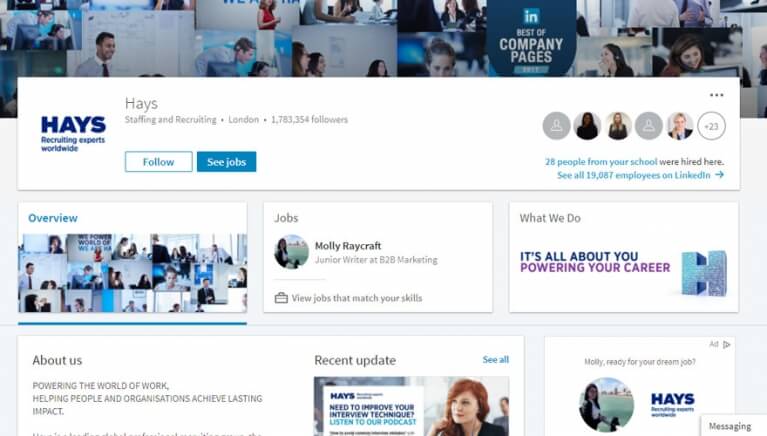
Look at the company profile of Hays — their recruitment firm provides job hunters with top employment tips and other best practice advice. By giving value to viewers, they attract potential clients, too.
By the way, the latter option can be implemented with Dashly pop-ups. You can address prospects by their names, which allows for a maximum level of personalization and better engagement.
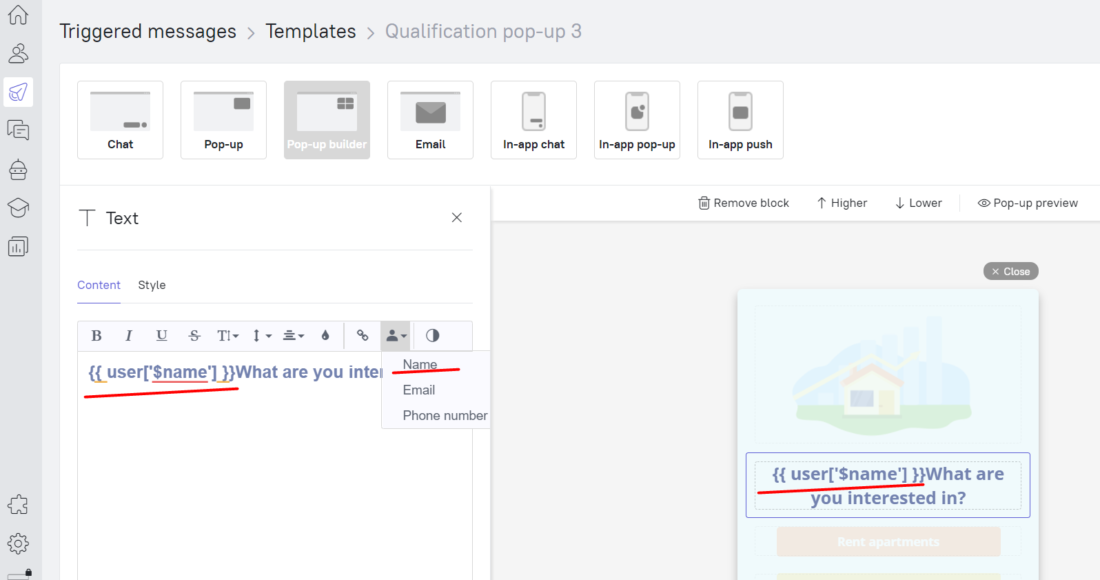
Account based marketing email strategies
To reach the highest level of personalization, you can target outbound channels and send emails. Take your time to craft pre-scripted letters and adjust the frequency of sending, for example, 5-7 letters per person during 2-3 weeks.
What exactly to write about? Basically, there are two approaches to email marketing:
- Informational content. These letters tend to be more effective when you are not targeting a particular salesperson or don’t know which decision-maker to appeal to. To raise engagement, offer a solution or provide another call-to-action (not necessarily sales). You can build a lineup of messages, eventually leading to making a certain action. By using informational content, you can also qualify leads and promote your brand.
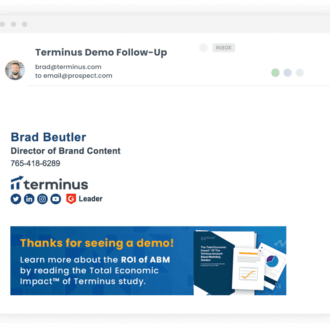
- Sales push emails. In these messages, you appeal directly to the accounts’ challenges. These letters work better when aimed at decision-makers. This approach also helps to gather more information about prospects. For sales push emails, personalization is essential as it improves the likelihood of the audience engaging with the email.
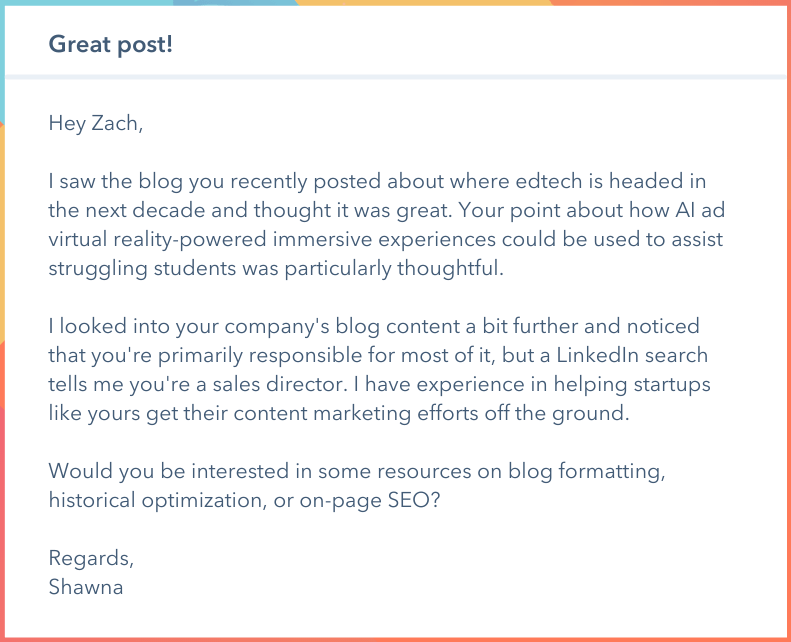
Direct marketing strategies
Depending on the value of the prospect, you can go 100% personal and send gifts or resources directly addressed to the company or its representatives.

Targeted presents
1) allow you to showcase the quality of your product;
2) grab attention from the people you’re trying to reach.
Although this is a resource-consuming approach. It can be justified in cases when you want to be noticed, and accounts are very important.
Networking strategies
Another way to find accounts is to search among your partners (and their partners, too). This approach can be useful for the B2B segment. Opt for cross-company engagement — ask for 3rd party introduction. It can improve your engagement with the people you’re selling to. Also, consider partnering with non-competing businesses to run marketing campaigns and invite local prospects to joint events.
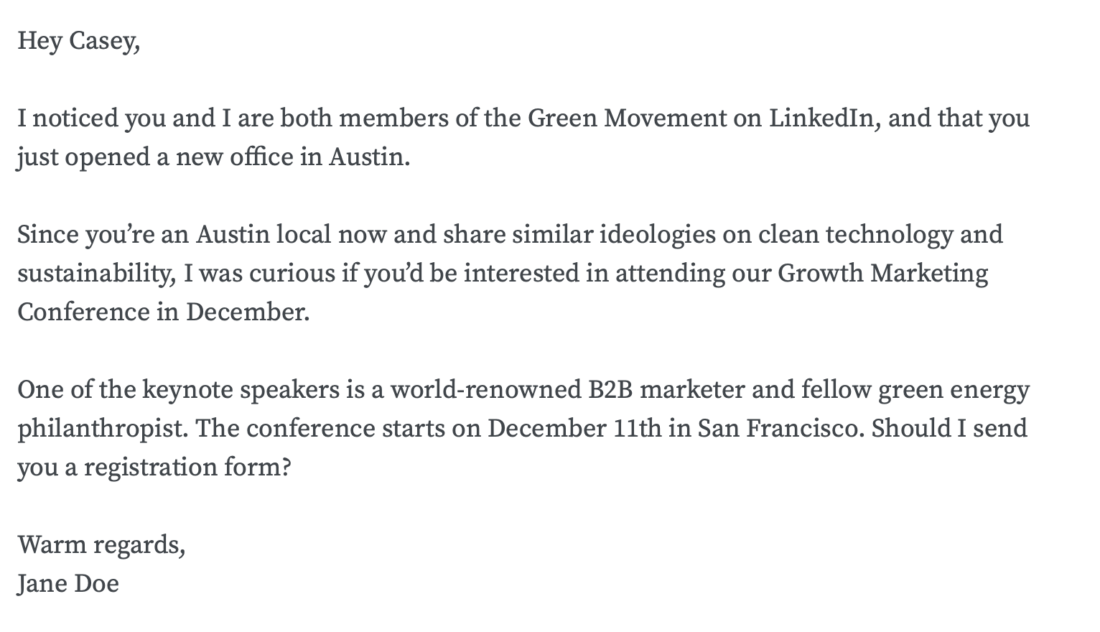
Intrigued by the variety of implementation options? Time to act!
Read also:
The Ultimate Guide to Sales Funnel Reporting Metrics
How to Create an Automated Sales Funnel That Converts
How to Implement Account-Based Marketing
Now, as we’ve studied theory, we can proceed to practice. How can the above-mentioned approaches be used in real life? Account-based marketing strategy boils down to five crucial steps — let’s observe them.
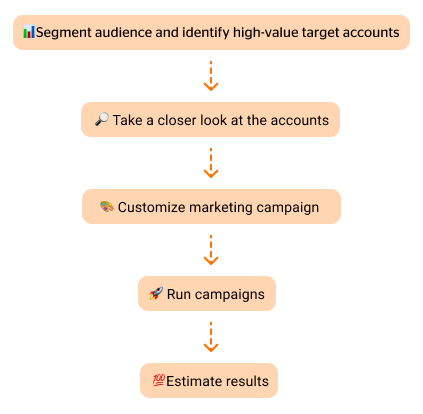
Step 1: Identify high-value target accounts
By applying the right tactics for prospect qualification, you can see your campaign efficiency soar. To make it possible with account-based marketing, you need to establish a framework for segmenting the database because this approach brings value through messaging and focused activities aimed at particular groups.
You can segment prospects according to:
- company size (number of people);
- company market capitalization, annual turnover, or other key metrics;
- current spending;
- certain products or services they use/need/offer;
- open and closed opportunities;
- geography;
…and so on.
Take your time to define audience segments and messages that might be appealing to them. At this very moment, the sales and marketing departments should unite and discuss the plan.
Typical ABM mistake №1: One person evaluating the account, we need to have a long term approach in mind. We should know how to make way and how to get the potential customer from one point to another. Most people think short terms because of their own targets or other limitations.
We need to approach the potential customer with the angle of helping their business and not selling our solution to them. It’s the trust that we have to gain, selling will happen in future based on this trust.
We need somebody to understand the product lifecycle also — where we are at currently, and where are we moving to next. If you know where you’re going, you’ll be in a better state to handle your accounts. Otherwise the conversation won’t hold that long.
We need to be an insider for any particular account. We need to know what role each person in the potential customer’s org is going to play. Analyze who is the decision maker, who is the creator, who is the mediator, who will be easy to convince, who understands the need of your product, etc.
We have to be one of them, to be able to sell. There’s a quote that keeps coming up in our sessions.
Selling happens through the heart. So, the connection has to be built — with everybody.
To reduce over-complication, you can implement automated customer data trackers featuring triggers and filters designed to work with account-related information. Such software helps to automate interaction and track the efficiency of communication, which makes the implementation of account-based marketing tactics much easier.
Different accounts anticipate different services, products, and most importantly, communication approaches from you. This is why it’s important to form segments before you select a few accounts to closely work with. In the Dashly interface, you can apply various filters and tags to divide leads into groups.
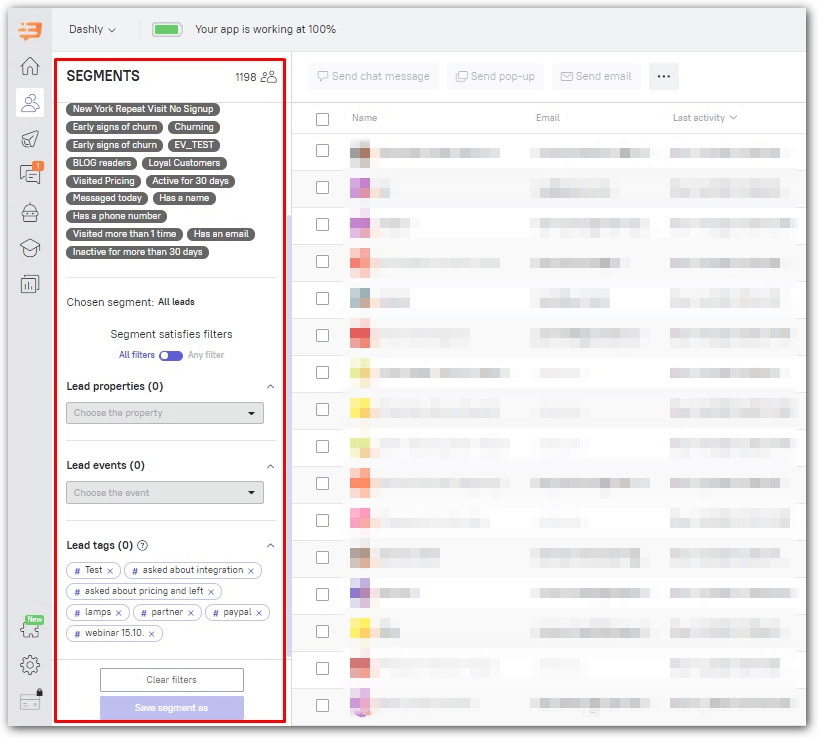
Once the database is formed, you can pick the best-fit accounts to start your campaign with. This process is described in our next step.

Step 2: Take a closer look at those accounts
Once you’ve defined the best-fit accounts, do your research on them. To find the best match for sales, you should dig deeper and try to figure out:
- pain points and goals of the prospects;
- who the key stakeholders are;
- who makes decisions;
- what they do or fail to implement to solve their problems.
All this and even more info about Dashly customers we knew with the help of the Jobs To Be Done framework:
Account-based marketing knowledge can boost your efficiency exponentially, but you need to know how to fetch information. Aside from direct communication with prospects, consider checking their social networks (Facebook, Twitter, LinkedIn) — there might be something to give you a hint on messages.
Typical ABM mistake №3: When people leave the org — the relation doesn’t get carried forward — and the next person has to build it again. So, never have 1 person handling it alone. Start with one and always have a back-up with the 2nd person also breaking the potential barrier — so in worst cases — they can take over and continue the relation.
At this moment, your sales and marketing departments should unite powers and rely on their cumulative experience. Explore each and every potential account: learn about their companies and stakeholders, relevant problems that your products could solve, and some other pain points to appeal to.
Typical ABM mistake №4: Lack of customer research
Before we prioritize the list, there is a need to know what kind of companies are required to be targeted. If we don’t already have an ideal customer profile (ICP), then putting one together should be the priority. We should know in detail who they are, their attributes, and their pain-points.
To ease the process of communication, import them into your Dashly database — it’s a matter of a few clicks. You can import users who registered on your website or collect prospects’ emails to message them directly.
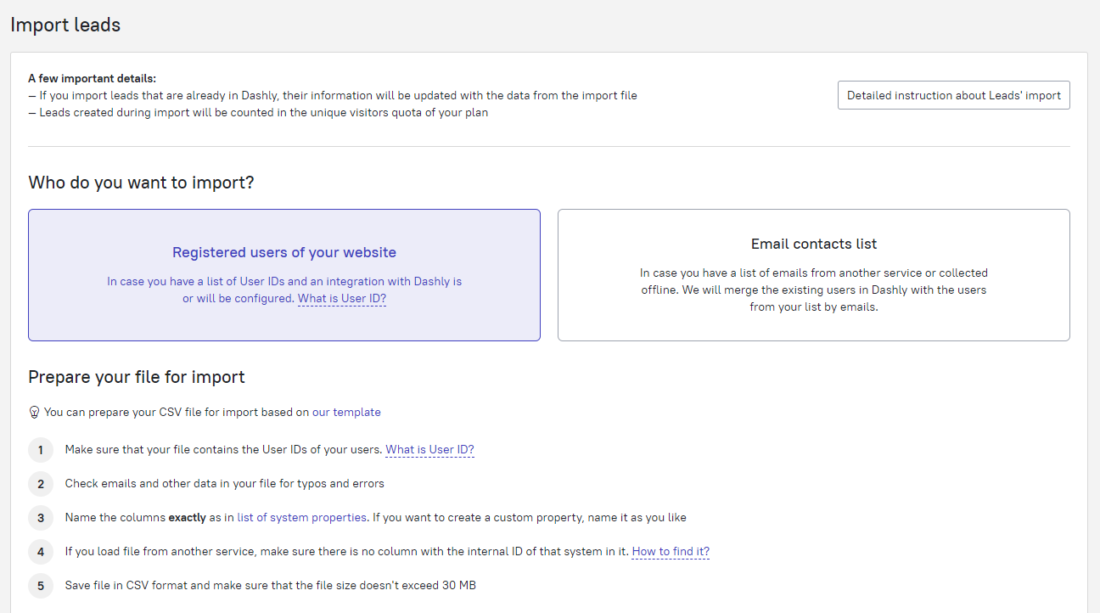
Finally, define where the prospects are on their customer journey.
Step 3: Customize a marketing campaign
Of course, what is ABM without planning? Now when you’re well aware of prospects’ needs and concerns, it’s time to transform your knowledge into a personalized strategy.
Your content and messages should be addressed directly to the prospect’s company and its stakeholders. When you realize what their pain points are, it’s easier to craft the content that appeals and raises interest.
Here’s a real example. Many SaaS companies cannot raise profit despite a huge lead database because sales and marketing departments stay in a passive war. This problem was revealed during interviews with the target audience. Hence, we changed the key message in our content from ‘Raise profit’ to ‘Align marketing and sales’.
Dashly users can choose from several types of content: chatbots, pop-ups, email letters, and so much more.
Once your creative is ready, you can specify the trigger event, audience, conditions for displaying the message, and goals to achieve.

Step 4: Run your marketing campaigns
It’s high time to launch and test your marketing directly on the account!
First and foremost, decide upon the channels you are going to promote on. Most often, companies use Facebook, LinkedIn, and Instagram — this is where stakeholders are present online. Besides, these platforms allow running campaigns to appeal to specific organizations and even titles (for example, ‘Employers’ or ‘Executives’).
At the same time, you might consider platforms that are linked to a company’s specialization. For example, if your ABM campaign targets someone from the cryptocurrency sphere, you’d better show them targeted ads on Coinbase or Cointelegraph. Graphic designers spend their time on Pinterest, real estate agents — on Trulia.
However, you should be careful not to bombard accounts with targeted content. Too much advertisement repels people. Especially when they encounter the same message over and over again.
In the Dashly interface, you can start your campaign and set the date for goals to be reached (specify events or metrics). Once it gets launched, you will see it in the list of active messages:

While the campaign is live, you can check real-time statistics on prospect engagement: clicks, replies, and goals achieved.
P.S.: Make sure you reach out to the whole organization, not particular people within it. You need to target stakeholders and decision-makers, so it’s important to find that special content to catch the attention of the right people.
Step 5: Analyze your marketing campaigns
We track upper and mid-funnel metrics in order to optimize, but we measure ABM success in sales and business terms as
- Target accounts in pipe
- Wins
- Average deal size
- Funnel velocity.
Putting funnel metrics and business outcomes together, we arrive at a full set of basic account-based marketing metrics.
After having your campaign running for a month or two, you can measure and evaluate the results and effectiveness of account-based marketing messages. Customer data platforms can show you detailed analytics, but don’t limit your estimations by numbers only.
To draw a verdict, ask yourself the following questions:
- Was your personalized content engaging? If so, what exactly has caught accounts’ attention?
- Are accounts engaged with your brand?
- Have you discovered the stakeholders in those companies? Did they view/interact with your content?
- Did you manage to earn revenue from these campaigns?
- Is there anything you might improve about your account based marketing plan?
ABM success can be measured with the no of good relations that you have — because you may/may not be able to sell them now, but in future you will always be the 1st one to be approached once the need arises. So, theoretically — it’s the relations you’re building. But not practically.
Another way to measure it is whether your customer refers somebody else to you -because that means you have gained their trust. They have that confidence in you then.
Practically — it has to be the no. of deals closed for the long term. Instead of a monthly, it has to be a yearly subscription, or longer than that.
In the Dashly interface, you can access trigger, manual campaign and funnel reports to see the results: how many were sent and replied, who bounced or unsubscribed, and so on.
If the results did not come up to your expectations, don’t despair. Account-based marketing strategy needs practice because every prospect is unique.
Typical ABM mistake №2: Patience. Not everybody has it. But we need to keep patience. SaaS products take time to sell, if the awareness, interest, desire, intent journey is big. You lose patience and the relation goes for a toss.
Identifying who we need to target — based on data — is also a challenge. Somebody needs to dig 1000 miles to understand whether the company has a need for your product or not. And hit at the right time.
The ABM approach can be very efficient, but it takes some time to figure out the most appealing content and timing (as well as accounts).
There is one more thing that can help you…
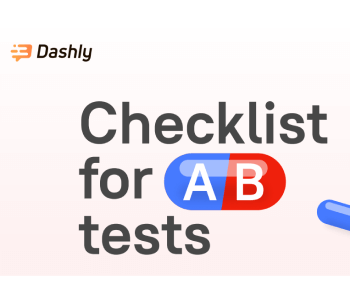
Test your pop-ups and email campaigns with Dashly.
Just sign up to try it 7-days free
FAQ
This is a strategy that combines the powers of marketing and sales departments to work with a few targeted prospects. It is based on the personalization of messages and qualifying the best-fit prospects.
Basically, it boils down to five steps. First, experts find the most suitable accounts (prospects who are most likely to buy, or certain companies). Secondly, these accounts are analyzed and studied closer. Thirdly, personalized content is prepared. Finally, the ABM campaign is launched, and its results are analyzed later on.
This strategy allows reaching out to certain prospects in the most efficient way. This is a great option for large sales and deals. ABM unites the experience of sales and marketing departments, and their common efforts multiply the positive effects of marketing. Finally, account-based marketing helps to optimize resources: instead of wasting time on communication with dozens of people, specialists focus on the best-fit prospects and fulfill goals quicker.
In most cases, it’s more than one person. An average committee board includes 7-20 decision-makers. The more people are involved, the longer a sales cycle takes. For this reason, a stakeholder-focused ABM is more efficient than a single-lead marketing approach.
Opt for Dashly, HubSpot, or Marketo.
Read also:
- The best way to collect emails: 5 top-notch methods unveiled
- 3-step guide on inbound lead qualification: how to qualify inbound leads on autopilot
- Choose your ideal lead nurturing platform: Top 10 software tested by experts
- How to implement user tracking on website: guide, tactics, and tools
- Top 10 user activity monitoring tools: tracking features, price, cons and pros
- The top 15 inbound marketing tools: harness digital power and elevate your business
- Top 12 lead qualification tools to deliver your sales hot leads only
- Top 20 best website tracking tools for effective work with visitors
- 20 AI sales tools: Boost your sales strategy with revolutionary technologies
- 15 customer retention tools: find out the best software to return your customers
- Top 10 best product marketing tools for your tech stack [expert review]
- 15 best user behavior analytics tools [software features & pricing]









![Sales and Marketing Automation: How to align their workflow to 2x revenue [Dashly example]](https://www.dashly.io/blog/wp-content/uploads/2021/06/IMG_1074-1100x471-1-720x308.jpg)




![What is sales enablement? Definite guide + Strategy + Tools for 2024 [CSO edition]](https://www.dashly.io/blog/wp-content/uploads/2021/03/sales-enablement-720x308.jpg)